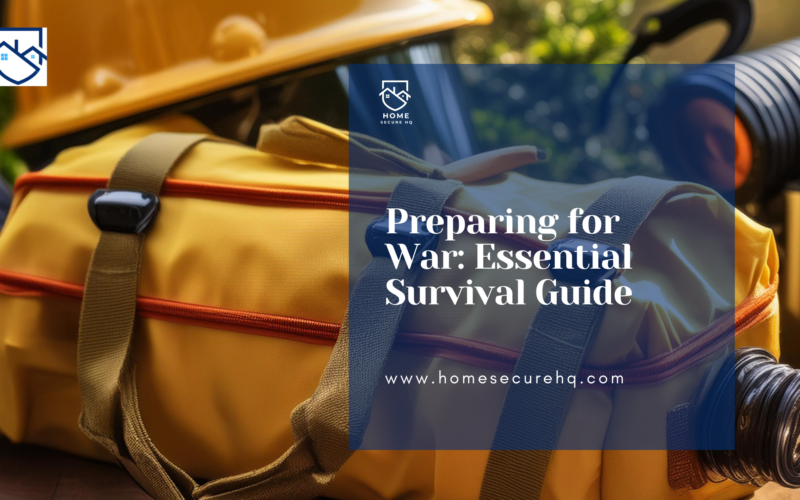The threat of World War III makes it vital to be prepared for the unexpected. The U.S. has 18 volcanoes that could cause big problems if they erupt. Also, the country sees more tornadoes than any other place in the world. This shows we need to be ready for emergencies or prepare for war.
This guide gives you a complete survival manual, steps and strategies for war preparedness. It talks about making an emergency kit, finding safe shelter, avoiding fights, learning survival skills, getting resources, and planning how to leave.
It’s all about giving you the knowledge and tools to survive tough times.

Whether it’s natural disasters or global conflict, being ready and informed helps a lot. By using the advice in this guide, you’ll be more prepared to face challenges. This ensures your safety and well-being when things get hard.
Assembling an Emergency Supply Kit
Getting ready for emergencies, like wartime, means putting together a detailed emergency supply kit. This kit should have all the must-have items to keep you and your family safe during a crisis.
By collecting these supplies, you boost your wilderness survival, emergency preparedness, and disaster readiness.
Basic Disaster Supplies
Start your emergency survival kit with these basic disaster supplies:
- Water (at least one gallon per person per day for at least three days)
- Non-perishable food (a three-day supply)
- Battery-powered radio and flashlight
- First aid kit
- Whistle to signal for help
- Dust masks (for everyone aged 2 and above)
- Plastic sheeting and duct tape for improvised shelters
- Moist towelettes, garbage bags, and plastic ties for personal sanitation
Additional Emergency Supplies
For better emergency planning and stockpiling, add these items to your kit:
- Prescription medications (at least a one-week supply)
- Infant formula, bottles, diapers, wipes, and diaper rash cream
- Pet food and supplies
- Cash (in small bills) and traveler’s checks
- Important documents (copies of identification, insurance policies, and bank records)
- Extra clothing, sturdy shoes, and blankets
Maintaining and Storing Your Kit
Keep your emergency disaster supplies kit in top shape and easy to find. Check the expiration dates on food, water, and medicine, and swap out any old items. Keep the kit in a cool, dry spot, and make sure everyone knows where it is. By doing this, you’ll be more ready for emergencies and disasters.
Finding Shelter During Wartime
When war comes, finding a safe place to hide is crucial. Look for strong buildings and build emergency shelters to stay safe. With good planning, you can increase your chances of staying safe.
Identifying Suitable Buildings
The best shelter is a strong, brick building with a basement. These can handle explosions well and keep you safe. Studies show 75% of people choose these for their safety.
If you can’t find a brick building, think about building a shelter in the woods. These shelters protect you from the weather and hide you from view. About 48% of people in the woods built these shelters to stay safe.
Constructing Emergency Shelters
If you can’t find a building, you might need to make your own shelter. You could dig a trench, build a lean-to, or use materials to make a bigger shelter. Make sure it’s warm, dry, and can handle threats like bombs or planes.
Being proactive and having a plan is key to finding shelter in wartime. Look for safe places before you need them and act fast when danger comes. This way, you can survive the war and come out unharmed.

Avoiding Confrontations and Learning Self-Defense
In wartime, it’s key to avoid fights whenever you can. Civilians often stay safe by staying out of trouble. Yet, knowing basic self-defense can help protect you and your family if you can’t avoid a fight. Being ready to defend yourself, but still aiming to avoid fights, can boost your survival odds.
When defending yourself, forget about weight classes, gear, rules, or referees. You might face many attackers and weapons, and your goal is to survive. How well you do in a fight depends a lot on what you do before it starts.
Good self-defense training should teach you how to prevent fights and use different levels of force. It should also teach you to be aware of your surroundings, stand up for yourself, and find safe ways out. Experts say training should include more than just hitting, like handling stress, learning to be aggressive, sparring, and making contact.
Remember, getting into a fight can lead to big legal problems if you’re not defending yourself. Aim for avoiding fights, learning self-defense, and using survival skills to stay safe in wartime.
How To Prepare For A War
With global tensions rising, preparing for war is more important than ever. It’s a complex task that starts with gathering key info and learning survival skills.
By staying informed and skilled, you can better face the challenges of conflict.
Gathering Crucial Information
It’s vital to keep up with the conflict’s progress, safe zones, and aid availability. Look for news from trusted sources, government agencies, and emergency groups.
Also, connect with your community and emergency networks for updates and advice.
Learning Survival Skills
- Learn first aid to help in emergencies.
- Get good at navigating with maps and compasses.
- Know how to purify water, preserve food, and save energy.
- Practice self-defense and crisis management for safety.
- Join emergency drills to test your skills and improve.
By getting the right info and survival skills, you can prepare for wartime challenges. Being informed and skilled boosts your chances of staying safe and well during tough times.

Securing Resources and Planning Escape Routes
With war threats rising, it’s key to act early to protect vital resources and map out escape paths.
Managing resources, storing supplies, and keeping water safe are key to surviving shortages or disruptions.
Hoarding Supplies and Valuables
Start by storing non-perishable food, water, medical items, and valuables. This ensures you can get through tough times on your own. Stock up on canned goods, dried foods, and bottled water.
Also, remember to include personal hygiene items, first-aid kits, and any needed prescription drugs.
Locating Clean Water Sources
Finding safe water sources is crucial for your survival plan. Besides bottled water, think about filling bathtubs, sinks, and containers with water.
Learn how to purify water with filters, boiling, or chemicals to keep a steady supply.
Planning for evacuation and logistics is also vital. Find several escape routes and know how to get around the area.
Practice evacuating twice a year, making sure everyone, including the elderly, disabled, kids, and pets, is included.
Securing resources, storing supplies, and planning for emergencies boosts your chances of surviving war.
A well-rounded plan for managing resources and evacuation is key to staying safe and alive.

Conclusion
Getting ready for war is tough, but being proactive can really help you survive. Start by making an emergency kit and finding a safe place to stay.
Also, try to avoid fights, gather important info, secure resources, and plan how to get out safely.
This will make you stronger and help you handle wartime better. The main thing is to be ready, keep your eyes open, and work together.
Facing the future can feel scary, but being prepared and looking out for each other can make a big difference.
It’s crucial to keep fighting for our rights and the life we want in these uncertain times.
By using the advice in this guide, you can protect yourself and help everyone get through this tough period.
Let’s work together to face the challenges of war and come out stronger and more united.








3 comments
Thanks for the marvelous posting! I genuinely enjoyed reading it, you could be a great author.I will ensure that I bookmark your blog and definitely will come back sometime soon. I want to encourage you continue your great writing, have a nice holiday weekend!
Thank you too
Thank you soo much